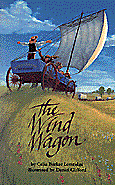


|
The Wind Wagon.
Celia Barker Lottridge. Illustrated by David Clifford. Subject Headings:
Grades 2 - 4 / Ages 7 - 9. **1/2 /4
|

excerpt:
Let me tell you a story about where that kind of wind took me. You might not believe it, but it's true. It's the story of the wind wagon. Just listen.
Celia Lottridge, author of the award-winning Ticket to Curlew, has given younger readers an exciting, fast-paced chapter book with The Wind Wagon. Based on a real-life event, the story captures the excitement of the pioneers in the mid-nineteenth century as they headed west looking for a new life.
Sam Peppard arrives in Oskaloosa in 1859 and settles in as the town's blacksmith. But, like many other young fellows, he wants to head further west to the Rocky Mountains. Unlike the others, he isn't prepared to go by ox cart which would take several months. So, preferring to go by wind rather than ox cart, he builds a wind wagon to sail across the prairie. The story continues with Sam's wait for the right wind and then his adventure as he finally "sets sail" for the west.
Young readers eager to explore "chapter" books will find The Wind Wagon easy to read in both vocabulary level and text type. The black and white illustrations by David Clifford are interspersed throughout the book and capture the flavour of the period as well as the humour and excitement of the plot. The illustrations also help the young reader make the transition from picture book to novel format.
Although Celia Barker Lottridge's fast-paced story will hold the attention of the younger reader, there are some aspects of the book that will be confusing to them. The American setting will be unfamiliar to many primary level Canadian children as will the use of miles in describing distance and speed. The historical background reference that "a lot of Indians had a lot to be sore about" will be confusing to younger readers since not enough information is provided.
The Wind Wagon definitely has merit as both an introduction to historical fiction and an introduction to novel reading. The humour and action will help sustain the interest of the younger reader. The novel might also be used in a literature circle group for the primary grades as its story lends itself to discussion - in this way, an adult can elaborate on the historical background and draw attention to the methods of travel used by the pioneers in the United States.
This novel is recommended as a beginning novel for students interested in the historical theme of pioneer settlement.
Recommended.
Janice Foster is currently a teacher-librarian/enrichment facilitator at Oakenwald School in the Fort Garry School Division in Winnipeg.

To comment on this title or this review, send mail to cm@umanitoba.ca.
Copyright © 1996 the Manitoba Library Association. Reproduction for personal use is permitted only if this copyright notice is maintained. Any other reproduction is prohibited without permission.
Published by
The Manitoba Library Association
ISSN 1201-9364
AUTHORS |
TITLES |
MEDIA REVIEWS |
BOOKSHELF
BACK ISSUES |
SEARCH |
HOME